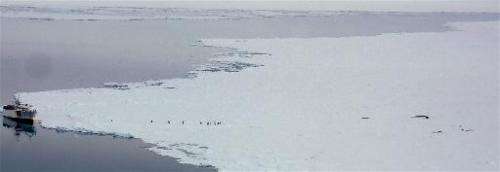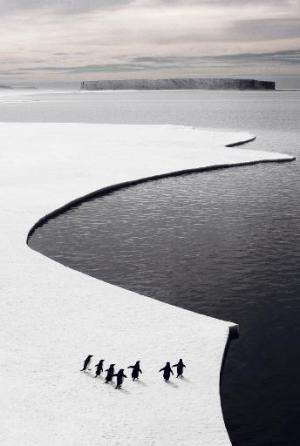Ice loss from West Antarctica on the increase

The West Antarctic ice sheet appears to be shedding far more ice than a few years ago, according to climate research unveiled Wednesday.
Previous research, conducted between 2005 and 2010, estimated that the ice sheet contributed 0.28 millimetres (0.1 inches) per year to the rise in global sea levels.
But three years of observations by Europe's ice-monitoring satellite, CryoSat, suggests that the contribution is now 15 percent greater.
The ice sheet is losing over 150 cubic kilometres (36 cubic miles) of ice per year, the European Space Agency (ESA) said in a press release.
The phenomenon is linked to a thinning of ice flows at three big glaciers—Pine Island, Thwaites and Smith, said polar scientist Malcolm McMillan, at Britain's University of Leeds.
"We find that ice thinning continues to be most pronounced along fast-flowing ice streams of this sector and their tributaries, with thinning rates of between four to eight metres (13 to 26 feet) per year near to the grounding lines—where the ice streams lift up off the land and begin to float out over the ocean," he said.
Climate scientists are casting a worried eye at the mighty ice sheets of Greenland and Antarctica.
There remain many unknowns about how this stored ice is responding to global warming, but the loss of just a significant chunk of it would threaten vulnerable coastal cities.

The global mean sea level rose by 19 centimetres from 1901-2010, an average 1.7 mm per year. It accelerated to 3.2 mm per year between 1993 and 2010.
In September, the UN's panel of climate experts said in their Fifth Assessment Report that loss of Greenland's ice sheet had probably increased from 34 billion tonnes per year in the decade to 2001 to 215 billion tonnes a year over the following decade.
In Antarctica, the rate of loss probably increased from 30 billion tonnes a year to 147 billion tonnes a year over the same timescale, the panel said.
Most of the loss came from the northern Antarctic peninsula, considered a "hot spot" where the rate of warming is several times that of the global average, and from the Amundsen Sea sector of West Antarctica, it said.
CryoSat uses a radar that measures the variation in ice height to high accuracy, enabling scientists to calculate the volume of the ice sheet.
The new findings were presented at a meeting in San Francisco, California, of the American Geophysical Union, ESA said.
© 2013 AFP


















